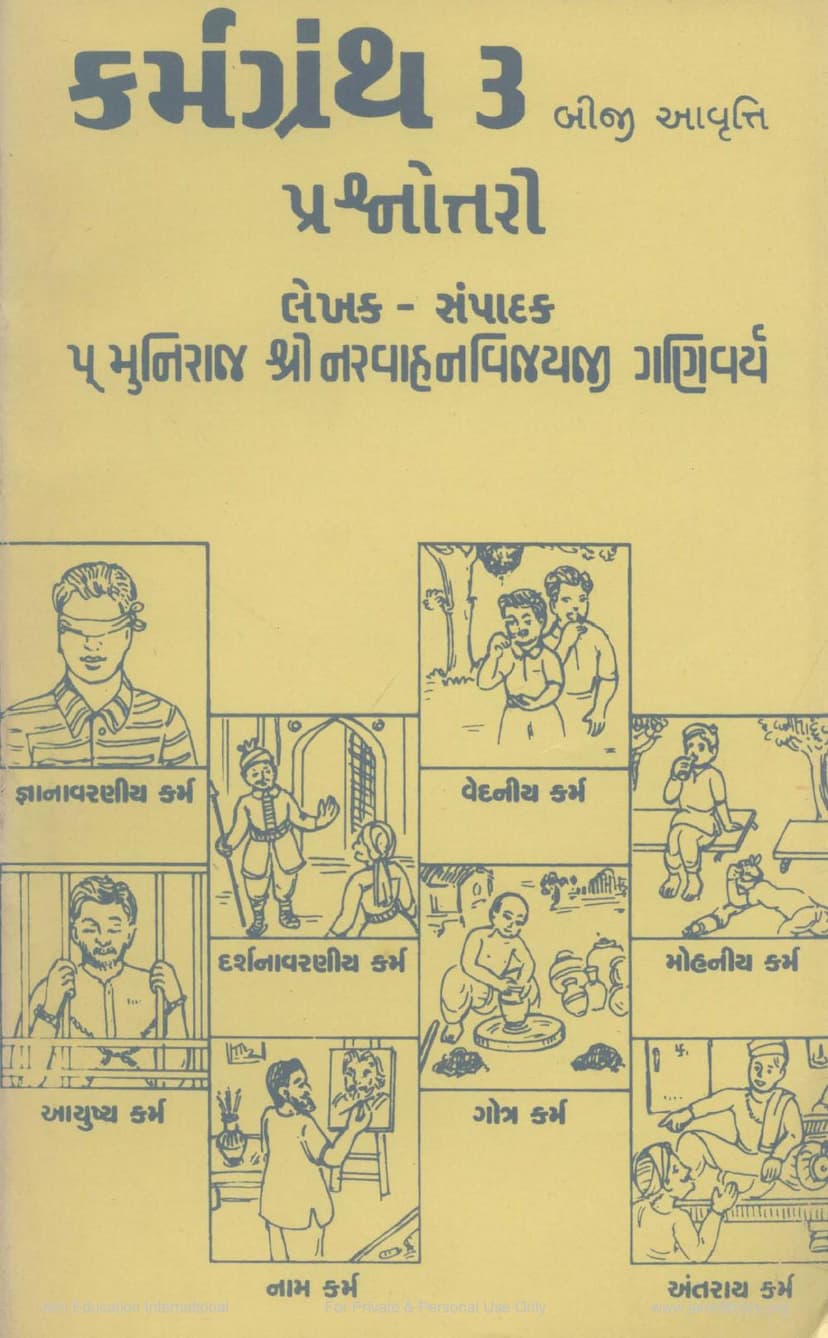Karmgranth 03 Prashnottari
Added to library: September 2, 2025

Summary
"Karmgranth 03 Prashnottari" (Karmgranth 03: Question and Answer) by Muni Narvahan Vijay, published by Padarth Darshan Trust, is a detailed exploration of Jain karmic theory presented in a question-and-answer format. The book aims to clarify the intricacies of karma, which is central to the Jain path of liberation.
The text begins with a traditional invocation to Lord Mahavir, free from the cycle of karmic bondage. It then proceeds to systematically explain various aspects of karma, often in response to specific questions. The core of the book revolves around the concept of marganas (ways of existence or classification) and how different karmic influxes (bandha) and their states (swamitva) vary across these marganas and through the stages of spiritual development (gunasthanas).
Key Themes and Concepts Covered:
- Karmic Bondage (Bandha) and Ownership (Swamitva): The book delves into how karmic particles attach to the soul and how the soul experiences these karmic effects.
- The Fourteen Marganas: The text meticulously details the karmic implications within each of the fourteen marganas:
- Gati (Destiny): Hell-beings, Animals, Humans, Gods.
- Indriya (Senses): One-sensed, Two-sensed, Three-sensed, Four-sensed, Five-sensed beings.
- Kaya (Body): Earth-bodied, Water-bodied, Fire-bodied, Air-bodied, Vegetation-bodied, and Sentient-bodied beings.
- Yoga (Activity): Mind-activity, Speech-activity, Body-activity.
- Veda (Disposition): Masculine, Feminine, Impotent disposition.
- Kashaya (Passions): Anger, Pride, Deceit, Greed.
- Jnana (Knowledge): Valid knowledge (Mati, Shruta, Avadhi, Manahparyaya, Kevala) and Invalid knowledge (Mati Ajnana, Shruta Ajnana, Vibhanga Ajnana).
- Sanyama (Restraint): Various stages of restrained conduct.
- Darshana (Perception): Various forms of perception.
- Leshya (Dispositional Coloration): Black, Blue, Grey, Yellow, Pink, White.
- Bhavya (Potential for Liberation): Souls with the potential for liberation and those without.
- Samyaktva (Right Faith): Stages of right faith.
- Sannin (Possessing Mind): Souls with and without a mind.
- Aahari (Consuming): Souls that consume and those that do not.
- Stages of Spiritual Development (Gunasthanas): The text tracks the changes in karmic bondage through the sixteen gunasthanas, from the stage of delusion (mithyatva) to the highest stages of omniscience (kevala jnana).
- Specific Karmic Influxes: It analyzes which souls bind which specific karmas (like Jinanama, Ayushya, Goti, Kashayas, etc.) and in which marganas and gunasthanas.
- Counting of Karmas: A significant portion of the book is dedicated to the precise enumeration of the number of karmic influxes binding at each stage and in each margana, often involving complex calculations of the 58 or 59 bhavas (states) that bind specific karmas.
- Exceptions and Specific Cases: The text also highlights exceptions and specific scenarios, such as the non-binding of certain karmas by souls in particular marganas or stages of development.
Structure and Methodology:
The book is structured as a series of questions and answers, making it an accessible guide for those seeking to understand the complex workings of karma according to Jain philosophy. Each question is followed by a precise, often numerical, answer, usually accompanied by a reference to the underlying principles or classifications. The author's expertise in karmic literature (karmasastra) is evident in the detailed and systematic presentation.
Overall Purpose:
"Karmgranth 03 Prashnottari" serves as a practical manual for understanding the causal relationship between actions, karmas, and the soul's journey through various existences. By breaking down the intricate subject into a digestible question-and-answer format, it empowers aspiring Jains with the knowledge necessary to navigate their spiritual path and work towards the cessation of karmic bondage, ultimately leading to liberation. The book emphasizes the importance of detailed knowledge of karmic principles for achieving spiritual progress.